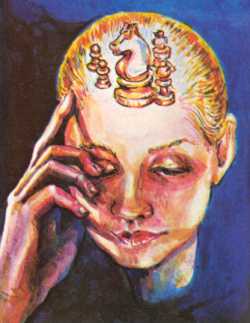| mind games |
Philip Joy looks at readers' chess games
SIMON Gross of Ipswich, has written saying that this page does not include sufficient details about the famous mind game, chess. With details from his letter and two chess games I hope to rectify this. First, a game sent by D Egdoll, of Glasgow with details of a game in which he played against Artic Computing ZXchessII. Another game is from P Robertson of Birmingham, who played the Micro-Gen version of chess at level 2.
|
|
Both games were won by the person who sent them. Why do you not send a game in which the computer won?
Both show that you can win in a few moves, which should prove to people who find a ZX-81 program difficult to beat that it can be done.
From the letters I receive it seems that for the player to win, it is a short game; if the computer wins or it is a draw it is much longer. If you send the games I would prefer you to use the first method of notation; it is the more standard one and is easier to read. If you have another method which you feel is just as good, please send it.
Gross, who has looked closely at Artic ZXchessII, spent many hours playing it and found some very interesting results but they did not prove how the game played.
He has sent a table showing what he thinks is the number of moves that chessII looks ahead on each level:
|

|
Where the moves are the same, in j1, 2 and 3, the time taken for a move was nine, 12 and 80 seconds. This might show that the game uses a different method to work out the moves on those levels. He adds that to look five moves ahead at the start of the game may show many thousands of possibilities but in the end game, five moves ahead might not be possible, as checkmate is in two.
I think the computer should look ahead as much as possible until its memory can hold no more. The levels should decide how long it spends doing this.
If you have done similar work on the version of chess you have, send the results.
I shall leave you with a problem sent by Gross which you can try on your version of chess for ZX-81. If your version lets the computer play itself, do that, otherwise let the computer play black. It is black's move and it has to avoid being mated in three.
The position, in standard chess notation, is: White: king on h1, queen e1, rooks e2 and e3, pawns h2, g2, f2 and a5;
Black: king h8, queen a6, rooks b8 and a8, pawns c4, f7, g7 and h7.
ZXchessII was mated in three moves at levels 0 to 5. It escaped in level 6 but took 7,200 seconds. Send your results and make them as detailed as possible. One good first move for black is a6-c6.
The winner of the competition, in which I asked for the address to which a program should jump to give the amount of free memory was Colin Norris of Essex.
Congratulations and if he sends a blank tape, with at least 20 minutes each side, I will record a copy of my Adventure.
The answer was 61. So to find the amount of spare memory print the line PRINT USR 61.
Anyone wishing to write to me about items in this column, or other Mind Games, can contact me at Essex. If you send tapes or other information which you would like returned, please enclose a stamped addressed envelope.